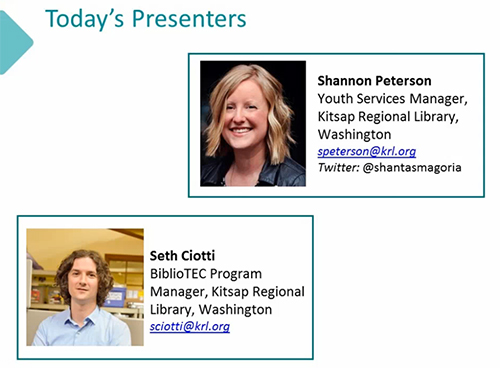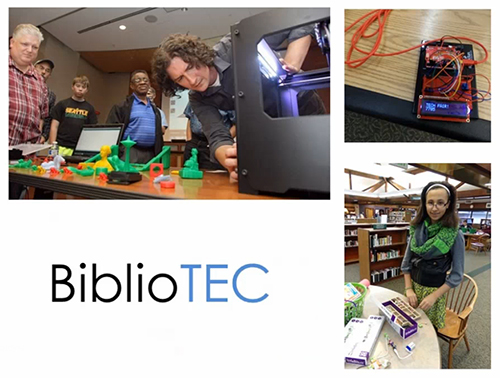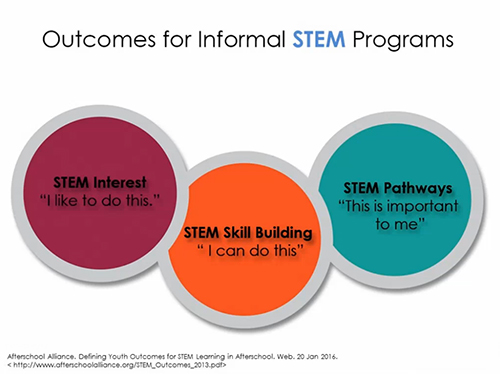How to Create a Robust STEM Library Program
STEM learning (that's science, technology, engineering and math) seems to be on the tips of tongues everywhere from teachers to library staff to the President of the United States.
But starting a new area of programming can sometimes feel daunting, especially when the focus is often on the advanced scientific tools from 3-D printers to robots. (see related article below)
 That's why it was so welcome to watch the recent webinar Make, Do, Share: Build a STEM Learning Community and hear presenter Shannon Peterson, Youth Services Manager at Kitsap Regional Library say "the tools and technology were nowhere near as important as the learning."
That's why it was so welcome to watch the recent webinar Make, Do, Share: Build a STEM Learning Community and hear presenter Shannon Peterson, Youth Services Manager at Kitsap Regional Library say "the tools and technology were nowhere near as important as the learning."
Peterson and colleague Seth Ciotti emphasized throughout the webinar that while it's easy to get focused on technologies, that community building with kids was the most critical element, so that kids could feel supported to experiment, question and even fail. "Learning can only happen well when you feel supported and connected," explains Peterson.
The library's first foray into STEM was creating the BiblioTEC program with a grant in 2012 from the Paul G. Allen Family Foundation. At first they spent a lot of time on technology and tools, but it turns out that while the tools were important, what the students wanted to learn and explore was way more important than the adults being experts on 3-D printers or other tools.
 This was just one of the essential lessons they learned in the BiblioTEC program and that they are now employing in their latest endeavor, the project Make, Do, Share: Build a STEM Learning Community. The project is wrapping up and they are putting finishing touches on a STEM Playbook due out at the end of June that will give more detail about the new model for STEM programming they created.
This was just one of the essential lessons they learned in the BiblioTEC program and that they are now employing in their latest endeavor, the project Make, Do, Share: Build a STEM Learning Community. The project is wrapping up and they are putting finishing touches on a STEM Playbook due out at the end of June that will give more detail about the new model for STEM programming they created.
The webinar provides a sneak peek at some of their key take-ways. "We focused on creating something that suits diverse library and community types, that suits the changing needs of youth in those communities, and also adapting to various staff comfort levels and experience," says Peterson.
One important aspect of offering STEM programming is being able to articulate why STEM is important (for example that STEM careers are growing three times faster than non-STEM careers, and the skill sets are applicable in many different jobs).
Another aspect is realizing what an important role libraries can have in offering a learning environment. Kids are in formal learning for 18.5% of their day, and libraries can offer a different environment for that is more built on kids' interests, is low-stakes and hands-on.
Library staff should start with a growth mindset, which Peterson explains is "that success or talent is not the result of fixed characteristic. So with effort and persistence it's possible to address and overcome challenges. Rather than thinking I am X or Y and I am who I am, this opens the door to new opportunity." And it allows kids to embrace the scientific method, trial and error, and risk taking.
Peterson and Ciotti both emphasized the importance of planning before starting a STEM program, saying it's essential to carve out the time to do pre-planning. Peterson spoke in detail about the steps to this planning, and I’ve included the outline below. The webinar includes much more detail on each step, along with ideas, examples and resources.
Road Map Planning and Learning:
1. Discover your community (Make a point to test your assumptions; it's easy to overlook the populations who aren't coming into the library.)
- Demographic data
- Community mapping - this doesn't have to be formal.
2. Focus on Facilitation ("Give up control as information gatekeeper and act as co-designer with youth," says Peterson.)
- Creates positive environment to model how to learn
- Build relationships with youth and families
- Have knowledge of different ages and stages
- Encourage collaboration and build community at the program
- Youth volunteers can be helpful
3. Develop Community Connections
- Don't have to operate in a silo, you can work with schools, community stakeholders, and more to create a "local STEM ecosystem." They can help you create a community of practice, and it helps you to complement instead of compete with existing community programs.
The most successful STEM programming involves planning for impact: intentionally incorporate ways to make the program about problem solving, creativity and learning, instead of simply providing access to technology. And also to think about outcomes: change that a recipient will have as a result of attending program.
Leading youth through stages of STEM programming builds confidence and curiosity for kids as well as library staff. Peterson described three types of STEM programming as:
 STEM Interest: "I like to do this."
STEM Interest: "I like to do this."
STEM Skill Building: "I can do this."
STEM Pathways: "This is important to me."
With each of these progressively more involved STEM projects, it's important to integrate youth voice and encourage youth ownership; focus on relationships; make time for planning and reflection; build a network; and embrace continuous learning.
Ciotti went on to give a detailed example from the soon-to-be-released STEM Playbook, with step-by-step "plays" on specific STEM projects. He says the playbook is designed to create a co-learning environment that helps youth explore with facilitators. "It's saying to youth, we're all here to discover together, to learn together."
The first, and simplest, type of STEM project are "BITS" programs that explore initial interest and serve as a good intro to kids and facilitators. They are a way to identify what to do next in projects focused on exploring and on youth being involved in the inquiry process and letting youth have time to plan and solve. Then youth start thinking about that larger subject; several sessions to learn in depth about a particular STEM topic with project-based learning.
Ciotti walked through developing a plan and how to create a program and outcomes around that plan. In the webinar he provides examples of how this leads to more involved and multi-session programming, and how to plan all the aspects of this from the challenge through reflection.
If you are starting or looking to reinvigorate your STEM programming, this webinar (which was hosted in collaboration with the Association for Rural & Small Libraries) is a great starting point. View the free, archived webinar on WebJunction and make sure to download the chat transcript for some good discussions
Related Resources:
- Make Do Share Project, including downloadable guide (pdf)
- Read webinar recap
- Association for Rural & Small Libraries
- 2016 Finalist, IMLS National Medal for Library Service, Kitsap Regional Library
- Carol Dweck - Mindset: the new psychology of success
- Annie E. Casey Foundation. Kids Count Data Center. http://datacenter.kidscount.org/
- Ready by 21. Program Landscape Mapping Packet. http://www.readyby21.org/resources/program-landscape-mapping-packet
- U.S. Department of Education. Data and Research
- Work Group for Community Health and Development. “Assessing Community Needs and Resources Toolbox” Community Toolbox. University of Kansas. http://ctb.ku.edu/en/assessing-community-needs-and-resources
- Family Creative Learning Facilitation Guides
- SEARCH Institute
- Ready by 21. Building Blocks for Effective Change: Broader Partnerships, Bigger Goals, Better Data, and Bolder Actions. http://www.readyby21.org/toolkits
- Remake Learning. “The Learning Network.” Remake Learning Playbook
- STEM Ecosystems. Key Resources. http://stemecosystems.org/resources/?resource-category=key-resources
- We learned in chat about Bus Stop Socials hosted by the Newport News Public Library System and their partners
- STEM programming ideas:
- STEM Resources on YALSA wiki
- Making for STEM Success, by Meredith Farkas in American Libraries
- STEM and STEAM Library Programs on Pinterest
STEM Programs in Libraries and Common Barriers
Crossroads, WebJunction's eNewsletter, asked in April about libraries' STEM program activities. About a third of respondents said they offered occasional formal programs that emphasize STEM, and about another third said they have regular formal programs, with about 14% responding they have informal science programming.
Some library staff shared the program ideas, and there were some interesting ones!
Brenda K. Miller, Director, New Madison Public Library (OH) shared, "One of the most popular was our hands-on messy science for children ages 5+ with various learning stations with fun science. Another popular one is when we have Boonshoft Museum [come] for a star and planet gazing night."
"We regularly offer workshops for children on topics including robotics, physics and astronomy, biology and ecology, and many more," says Marcia Divack, Branch Manager, Alpharetta Branch of the Fulton County Library System (GA). "We have partnered with an outside group Atlanta Girls in STEM to provide instructors for each workshop."
Margaret Woodruff, Director, Charlotte Public Library (VT), says they partner with local companies, Charlotte Central School and the Champlain Mini Maker Faire. And the library held "TinkerBelles: Introducing girls in 3-5 grades to women who work in STEM careers through interactive presentations and projects."
Many of the library staff responded that they experienced barriers to offering STEM programming: the biggest three were funds, staff interest, and that they didn’t feel they have enough understanding or experience.
For the last one, watching the webinar Make, Do, Share: Build a STEM Learning Community would be a great first step!
